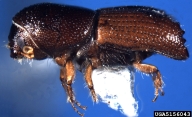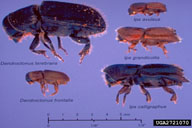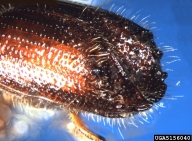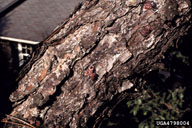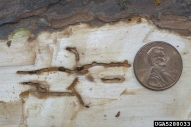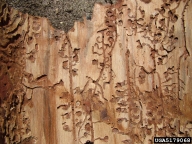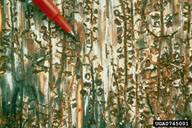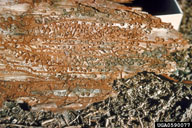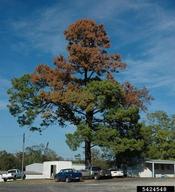Small southern pine engraver
Ips avulsus Eichhoff (Coleoptera: Curculionidae, Scolytinae)
Orientation to pest
The small southern pine engraver, Ips avulsus Eichhoff, is a native North American bark beetle found throughout the eastern United States. It is the smallest of the various species in this genus that breed in eastern pines. Attacks are concentrated on sections of trees with thin-bark, such as young pines or the limbs and tops of older trees. Attacks may occur in young trees and the tops of large living trees, which may be killed. However, when large living trees are attacked, the infestation is usually limited to the upper crown, and the mid- and lower boles of the same tree are often colonized by other species of Ips (Ips calligraphus Germar, Ips grandicollis Eichhoff, or the southern pine beetle (Dendroctonus frontalis Zimmermann). Any tree cutting or accidental injury that creates a pitch flow can induce attack by this species. Adults are very small (2-3 mm) and the tip of the abdomen (the depressed area) is shallow, with deep knobs and four small teeth on each margin. Males create a nuptial chamber and produce a pheromone that attracts one or more females. After mating, each female constructs a linear oviposition gallery in the inner bark that parallels the grain of the wood. Larval galleries are short and transverse, and each ends in a pupal cell in the phloem when the larva completes development. Pine engraver beetles can vector a blue stain fungus, which aids the beetle in killing the host tree by clogging the water-transporting elements in the tree. Symptoms and signs of pine engraver attack are essentially the same as those of many bark beetles, including the yellow, red, or brown foliage characteristic of dying trees, together with boring dust and pitch tubes on the bark. In the southern United States, there may up to 10 or more generations per year.
Hosts commonly attacked
Ips avulsus breeds in various southern pines, including eastern white (Pinus strobus L.), loblolly (Pinus taeda L.), longleaf (Pinus palustris Miller), pitch (Pinus rigida Miller ), pond (Pinus serotina Michx.), sand (Pinus clausa [Chapm. ex Engelm.] Sarg. ), shortleaf (Pinus echinata Miller), slash (Pinus elliottii Engelm. ), and Virginia (Pinus virginiana Miller) pines.
Distribution
The small southern pine engraver occurs from Pennsylvania to Florida and west to Texas.
Images of small southern pine engraver
| Figure 1. Adult (left) of the small southern pine engraver, Ips avulsus, which is the smallest of the eastern Ips species, as seen in relation to the other southern pine bark beetle species (right). | Figure 2. The depressed region at the posterior of the small southern pine engraver is shallow, with strong knobs on its surface and four teeth along each side. | |
| Figure 3. The pitch tube of the small southern pine engraver (center of photo, small) | Figure 4. A pair of small southern pine engraver beetles in their nuptial chamber, showing associated oviposition galleries | Figure 5. Short galleries made by larvae radiating out from linear oviposition galleries of the small southern pine engraver |
| Figure 6. Galleries, pupae, and larvae of the small southern pine engraver | Figure 7. Pupal cells of small southern pine engraver give a paddle-like appearance to the larval galleries | Figure 8. Attacks of the small southern pine engraver on larger trees are concentrated in the tops of trees (here, a loblolly pine [Pinus taeda]) |
Important biological control agents related to this pest species
The natural enemies of the small southern pine engraver have not been reported but likely are similar to those of other Ips species.
Web links for information on small southern pine engraver
- Forest Insect & Disease Leaflet 129 | USDA Forest Service
- Featured Creature Fact Sheet | University of Florida and FDACS
Articles
- Foltz, J. L., E. P. Merkel, and R. C. Wilkinson. 1984. Annotated bibliography of Dendroctonus terebrans (Oliver), Ips avulsus (Eichhoff), Ips grandicollis (Germar) in the southeastern USA. Monograph #12, Agricultural Experiment Station, University of Florida, 47 pp.
- Birch, M. C., P. Svihra, T. D. Paine, and J. C. Miller. 1980. Influence of chemically mediated behavior on host tree colonization by four cohabiting species of bark beetles. Journal of Chemical Ecology 6: 395-414.
